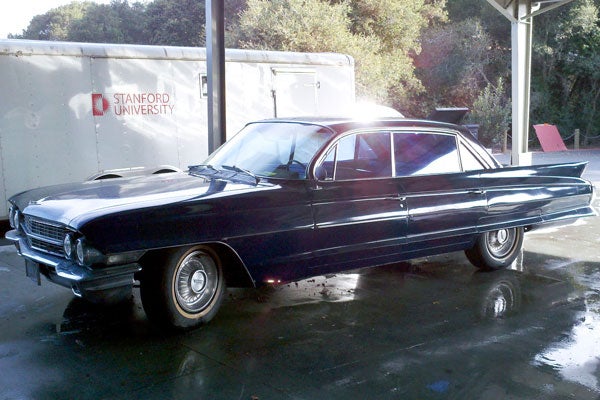|
View video here.
June 14, 2012
New class lets Stanford students restore a piece of Americana
A new course in mechanical engineering explores product design and manufacturing through the restoration of an old Cadillac DeVille. By Brooke Donald

The students are restoring a '62 Cadillac DeVille that has been in PhD candidate Greg Kress' family for three generations. (Photo: Courtesy of Greg Kress / Stanford University)
The course description for a new seminar in mechanical engineering describes exploration into topics of design and manufacturing, and tells students they will consider questions of American identity and history.
Then it says this: Every student can expect to get his or her hands dirty.
"This quarter we decided to try something a little different, a little scary," says Greg Kress, a PhD candidate in mechanical engineering who is helping teach the class.
That's ME397: Design Restoration. And in it, students learn by restoring a 1962 Cadillac DeVille – the car, complete with space-age fins, that defined luxury in that bygone era.
The students have worked on installing new brakes, pulling out and repairing the engine, hooking up a new transmission and pretty much rewiring everything.
"People don't build cars like this anymore. People don't build products like this anymore," Kress says, pointing to the blue Cadillac propped up on blocks in the lot of the Volkswagen Automotive Innovation Lab. "But this whole car comes from an era. And you have to ask, what does it symbolize? What does it represent?"
A goal of the class was to explore those questions and understand design through the eyes of the manufacturer. Another was to have the car running by quarter's end.
"I had no reason to believe that wasn't a perfectly reasonable goal," Kress said. "Turns out it was. Now we're just desperately trying to get it mobile enough to move."
The car belonged to Kress' grandfather and took him on cross-country sales trips. It transported Kress' father to college.
More recently, however, it was sitting in a garage like a "big piece of junk."
Kress always wanted to restore it but didn't have the know-how or the means. He also didn't want to complete his studies in engineering without ever having tinkered with a car. He didn't think other students should either.
"Maybe that's just an old-fashioned way of thinking, but to graduate with multiple degrees in mechanical engineering and not actually know how a brake works doesn't seem to make sense," he said.
So the course was born. A 1-credit class, it's part of Stanford's Revs Program, which studies all things car from an all-discipline point of view, including art, history, engineering, design and social science.
The students in the class are computer scientists, fine arts majors, mechanical engineers and product designers.
"When it comes down to getting in there with a grinder," Kress says as he points to a student crouched in the space where the engine will be, "it doesn't matter what major you are. That's a nice thing with this class. There's a leveling effect. It's too complicated for any one of us."
Kress describes the class as having three parts: basic shop class, project management and design inquiry.
"What really attracted me to this class was exploring the car not only as a mechanical object but as a piece of design," said Alex Gamburg, a junior majoring in design.
His hands grimy from tinkering with the brakes, Gamburg said he hardly even drives cars, let alone repairs them.
"This has been a very demystifying experience in some ways and in other ways I'm even more amazed these things actually roll because of the difficulties we've had to go through," he said.
Some of the difficulties had to do with getting parts for something so old. And while Kress purchased an old repair manual, it still left questions about how to do certain tasks.
"There's a lot of sourcing to be done [on parts]," said Marcus Albonico, a first-year master's student in mechanical engineering. "It's a headache, but the more you do it, the better you get at it. So I've gotten much better through this course."
"One of the biggest things I've learned at Stanford is the power of building a good team," Kress said. "We have a few informal rules in this class. One is to not work alone. Another is if you don't know how to do something, find someone who does. And if you do know how to do something, find someone you can teach."
The course met weekly throughout spring quarter. There are no exams and no grades.
"The structure is fluid. The course is designed so that whatever you want to tackle, you can tackle it," Kress said.
As long as you're OK with getting your hands dirty.
-30-
|